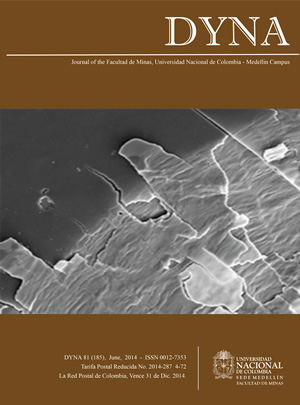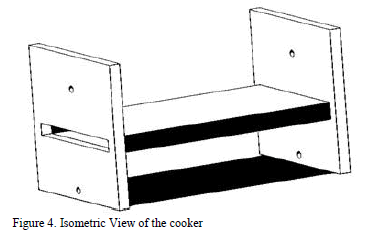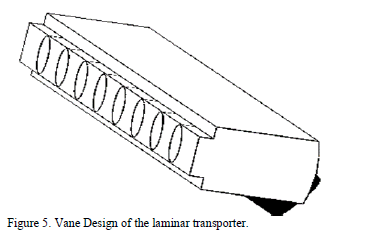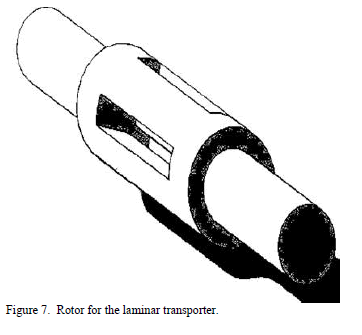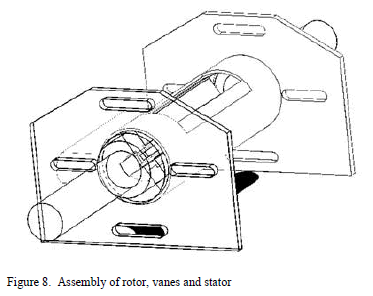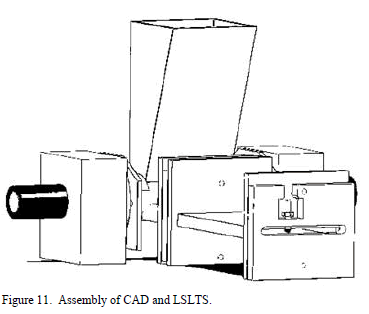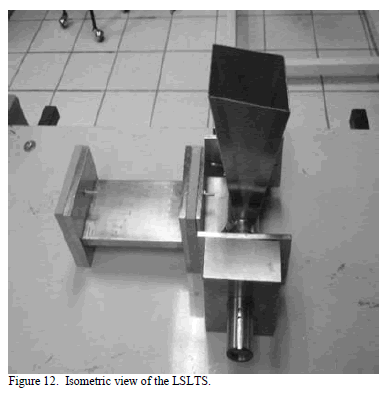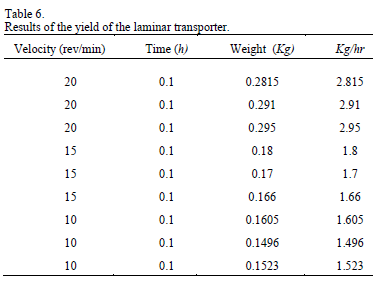Design and construction of low shear laminar transport system for the production of nixtamal corn dough
Diseño y construcción de un sistema de transporte laminar de bajo cizallamiento para la producción de masa de maíz nixtamalizada
DOI:
https://doi.org/10.15446/dyna.v81n185.33909Palabras clave:
Mechanical design, nixtamal, low shear, tortilla (en)Diseño mecánico, nixtamal, bajo cizallamiento, tortilla (es)
Descargas
https://doi.org/10.15446/dyna.v81n185.33909
Design and construction of low shear laminar transport system for the production of nixtamal corn dough
Diseño y construcción de un sistema de transporte laminar de bajo cizallamiento para la producción de masa de maíz nixtamalizada
Jorge Alberto Ortega-Moody a, Eduardo Morales-Sánchez b, Evelina Berenice Mercado-Pedraza c, José Gabriel Ríos-Moreno d & Mario Trejo-Perea e.
a Instituto Tecnológico Superior de San
Andrés Tuxtla, Veracruz, México. jorgemoody@gmail.com
b CICATA-IPN, Querétaro, México. emoraless@ipn.mx
c Universidad Autónoma de Coahuila, Coahuila,
México, bere_3181@hotmail.com
d Universidad Autónoma de Querétaro, Querétaro,
México, riosg@uaq.mx
e Universidad Autónoma de Querétaro,
Querétaro, México, mtp@uaq.mx
Received: October 10th, 2012. Received in revised form: October 8th, 2013. Accepted: October 25th, 2013.
Abstract
The tortilla is obtained by the traditional process of
nixtamalization. This process has two disadvantages: production of liquid waste
and it is in batches. Extrusion has resolved the problem of liquid waste,
however, extrusion as of yet, has not been able to replace the traditional
process of nixtamalization. This is because corn dough is a pseudoplastic
fluid, which changes its viscosity in the presence of high shear velocities
that occur inside the extruder. With this in mind, the following investigation
proposes the mechanical design and construction of a low shear laminar
transport system (LSLTS) for the production of corn dough for tortillas. This
system consists of two thermally isolated stages: transport and cooking stages.
The results showed that the prototype obtained meets the characteristics of
homogenous cooking, low shear, absence of liquid waste and the product meets
the specifications for nixtamal dough.
Keywords: Mechanical design, nixtamal, low shear, tortilla.
Resumen
La
tortilla se obtiene por medio del proceso tradicional de Nixtamalización. Este
proceso tiene dos inconvenientes: producción de efluentes contaminantes y ser discontinuo. La extrusión, ha resuelto
la problemática de la generación de efluentes contaminantes, sin embargo, no ha
podido sustituir al proceso tradicional de nixtamalización. Esto se debe a que
la masa de maíz es un fluido pseudoplástico, el cual cambia su viscosidad en la
presencia de velocidades de cizalla que ocurren dentro del extrusor. Con base a
lo anterior, el presente trabajo propone el diseño y construcción de un Sistema
de Transporte Laminar de Bajo
Cizallamiento (STLBC) para la producción de masa para tortilla. Este sistema consiste de dos etapas aisladas
térmicamente: Etapa de transporte y de cocimiento. Los resultados mostraron que
el prototipo obtenido cumple con las características de cocimiento homogéneo,
bajo cizallamiento, no produce efluentes contaminantes, y la masa obtenida,
cumple con especificaciones de masa nixtamalizada.
Palabras clave: Diseño mecánico, nixtamal, bajo cizallamiento, tortilla.
1. Introduction
In Mexico, the tortilla is the most consumed corn product (made in mills and with instant flours), however, in the United States the principal use of corn is the elaboration of snacks. Nixtamalization is the process used to produce the dough necessary for making tortillas. This traditional process is an environmental problem because it generates great quantities of liquid waste due to the fact that the contaminated water, product of the process, is channeled into the cities' sewage system, thus becoming a serious ecological problem [1-3].
Different investigators have developed alternative methods in an effort to solve the problem of liquid waste; for example, Sánchez Sinencio and González Hernández [4] have reported processes and equipment in order to obtain nixtamal corn-dough based on extrusion and infrared cooking, Figueroa [5-7] has developed ecological processes to obtain nixtamal corn-dough, Martínez [8] built a corn flour plant using a method based on vapor reactors and another method of cooking using radio frequencies (RF), Vaqueiro M. C. [9] patented a process of nixtamalization based on the separation of the corn parts.
One of the most viable alternatives to solve the problems of the traditional process is the use of extrusion. The investigators that have applied this method for the elaboration of tortillas are Duran de Bazúa [10], Martínez Flores [11-12], Gómez Aldapa [13], San Martín Martínez [14], Reyes Moreno [15], Milán-carrillo [16] and Gutiérrez Dorado [17] who developed an extrusion method for the production of corn-dough.
One disadvantage of the process of extrusion is the shear velocities that are generated inside the extruder, which results in a change of viscosity in the material. These changes make the corn-dough obtained difficult to process in the tortilla machines. For this reason, extrusion has not been able to substitute the traditional process in the production of nixtamal corn-dough. However, the extrusion method has many great advantages: it is ecological because it only uses the necessary amount of water for the process, also it is energy efficient compared to gas and it significantly reduces the process time.
For practical purposes, we have decided to use the name raw material to refer to the material produced by the combination of corn flour, water and calcium hydroxide. This raw material shows physicochemical changes when it cooks and reaches gelatinization becoming a Non-Newtonian fluid. This type of fluid changes its viscosity in the presence of shear stresses [18]. For this reason the extrusion has not been able to substitute the traditional method in its entirety because in the traditional method the material is at rest and there is no shear. The change of viscosity is reflected in the quality of the final product [19] such as tortillas and snacks.
In this context, this investigation proposes the development of a Low Shear Laminar Transport System (LSLTS) for the elaboration of instant corn flour for tortillas and/or corn-dough for snacks. The term low shear refers to the fact that the cooked corn dough does not undergo mechanical stress [18].
The basic proposal is to diminish the shear by separating the cooking stage from the transport stage where shear velocities are generated due to the rotative elements of the pump. In order to diminish the shear it is also necessary that the corn dough flows in a laminar manner, in order to obtain low shear the geometry of the cooker is determinate.
2. Methodology and Design
2.1. Methodology
The methodology employed in the design can be observed in Fig.
1, which begins with a series of process specifications in order to carry out
the conceptual design of the laminar cooker and transporter. Once the geometry
is found that meets the initial specifications, a detailed drawing for
fabrication proceeds. Finally, the simulated, conceptual and real data is
validated.
The specifications of the LSLTS for the elaboration of nixtamal corn flours or corn dough must have the following characteristics:
- Transport and cooking stages must be separate to avoid cooking the material at the same time that it's being transported and thus avoiding the presence of shear when the material is undergoing physicochemical changes.
- The transport and cooking stages must be thermally isolated so that the cooking zone is confined to the cooker.
- The design of the cooker must be optimum in length and cooking time.
- The design of the fluid laminar transport system must diminish shear velocities.
2.2. Design
2.2.1. Cooker
design
In order to carry out the modeling of the design it is
necessary to determine the specification of the machine. Also, it is important
to validate the design and cook the material that will be processed in order to
determine the mode and ranges of operation. Table 1 shows the rheological
characteristics of the material to be processed [20] (Corn flour) and Table 2 shows the gelatinization temperatures of the corn flour [18]. The heat
transference in the cooker is regulated by the thermodynamic constants of the
material listed in Table 3.
According to the previous information it can be concluded that the temperature of the material while exiting the cooker should be within a range of 70.7°C to 78.1°C. Furthermore, the temperature of the walls of the cooker should not go beyond 100°C because the water content of the material can evaporate and form vapor bubbles inside the cooker.
The proposed yield for the cooker design is 1.5 Kg/h as demonstrated in Table 4.
The geometry used for the cooker is rectangular as demonstrated in Fig. 2. This configuration is ideal for the process due to the fact that the entrance and exit are identical and there are no changes in pressure or velocity internally. Another benefit of this configuration is that the material is obtained in laminar form, which reduces shear.
In order to determine the dimensions, it is necessary to characterize the cooker using thermodynamic equations for the transference of heat with a forced internal flow as shown in Fig. 3.
The eq. (1) describes the transference of heat by
convection in a fluid through a duct  with
a certain mass flow (m) [22]. Due to
the fact that the constant of convection h varies according to the geometry of the cooker, it is necessary to use a
correlation with a Nusselt number (
with
a certain mass flow (m) [22]. Due to
the fact that the constant of convection h varies according to the geometry of the cooker, it is necessary to use a
correlation with a Nusselt number ( .
Because the nixtamal corn flour is a pseudoplastic fluid, Nusselt is proposed
for non-Newtonian fluids with variable viscosity as demonstrated in eq. (2)
[22]:
.
Because the nixtamal corn flour is a pseudoplastic fluid, Nusselt is proposed
for non-Newtonian fluids with variable viscosity as demonstrated in eq. (2)
[22]:
 (1)
(1)
 (2)
(2)
Where  is the duct perimeter, Cp is the specific head, D is the duct diameter, L is the duct
length,
is the duct perimeter, Cp is the specific head, D is the duct diameter, L is the duct
length,  is the thermal conductivity coefficient,
is the thermal conductivity coefficient,  is the viscosity,
is the viscosity,  is the Reynols number and
is the Reynols number and  is the Prandtl number.
is the Prandtl number.
Isolating the constant of convention h in eq. (1) and eq. (2). The following equations are obtained respectively:

Combining eq. (3) and eq. (4), the length of the cooker is obtained:

The eq. (5) is for cylindrical ducts. In order to obtain the equivalent in rectangular the diameter D is substituted for the hydraulic diameter in a rectangular duct:

Substituting eq. (6) in eq. (5), the result is:

The dimension  is
therefore proposed and the dimension y and
the length are estimated with the eq. (5).
is
therefore proposed and the dimension y and
the length are estimated with the eq. (5).



2.2.2. Assisted
Computer Design for the Cooker
The mechanical design assisted by computer or CAD (computer-aided design) was developed in SolidWorks 2009
with the following dimensions:



Fig. 4 shows the isometric view of the cooker.
2.2.3. Laminar Transport Design
The design is based initially on the vane pumps with
modifications according to the requirements of the cooker. This design proposed
that the transporter has a mass flow of 1.5  and an exit with the same geometry as the
cooker so that there are no changes in pressure or alterations in the flow
lines.
and an exit with the same geometry as the
cooker so that there are no changes in pressure or alterations in the flow
lines.
The first step is to determine the caudal necessary to
pump 1.5  .
The mass flow and the density in the eq. (8) are substituted and the result is:
.
The mass flow and the density in the eq. (8) are substituted and the result is:

Where the  is the mass flow and
is the mass flow and  is the density.
is the density.

Once the necessary caudal is obtained, an estimate is made
as to how many revolutions the mixture must make. In this case it is proposed
that the caudal make 1.5  in 15
in 15  (n) in
order to determine the capacity in cubic meters necessary for the material
contained in the transporter in one revolution. This capacity is the
displacement in the eq. (9). When the values are substituted, the result is:
(n) in
order to determine the capacity in cubic meters necessary for the material
contained in the transporter in one revolution. This capacity is the
displacement in the eq. (9). When the values are substituted, the result is:

The use of a stainless steel tube of 47mm in diameter is proposed to design the transporter. According to the stator and the displacement, the dimensions of the vanes and rotor are determined.
2.2.4. Assisted Computer Design for the Laminar
transporter
According to the estimated dimensions, the dimensions of
the laminar transporter can be determined. The first element that must be
designed is the vane with holes to contain 6 mm springs as shown in Fig. 5.
The next pieces that must be designed according to the specifications are the stator and the rotor as shown in figure 6 and Fig. 7 respectively. In Fig. 8 the assembly of the stator, rotor and the vanes is shown. Finally, Fig. 9 shows the complete assembly of the laminar transporter.
2.3. Manufacture of the LSLTS
The material that was selected for the
thermal isolator was Bakelite due to its thermal isolating capacities with a
very low coefficient of conduction of 0.233 (see Table 5). Stainless steel was
selected for the cooker due to its capacity to conduct heat and its food grade
characteristics. As a result of the selection of materials, the isolator was
manufactured as shown in Fig. 10.
Fig. 11 shows a representation of the CAD assembly and the mechanical manufacturing of the LSLTS. In Fig. 12 the isometric view of the construction of the LSLTS can be observed.
3. Tests and Results
Tests were run at the CICATA campus Querétaro with a temperature of 79 centigrade in the cooker, as proposed, and corn flour with a humidity of 55% and a granulometry of 1.3. Four things were tested: flow, temperature, viscosity, and water absorption index.
3.1. Flow test
In
order to affirm that the implementation of the transporter meets the
requirements of the design, tests were done with corn flour at 55% humidity and
the range was varied between 10 and 20 rev/min. The results are shown in Table
6.
In
the table above it can been observed that the transporter pumps approximately
1.5  at 10
at 10  .
.
3.2. Temperature Test
The objective of this test is to determine if the material
reaches the desired temperature when exiting the cooker. In this test it is
assumed that the dimensions of the cooker estimated by the theoretical method
and the simulation are ideal and will concur with the results of the
experiment.
During this test a range of yields of 3 to 1.5 kg/h were tried using the velocity control on the motor connected to the extruder. The results can be observed in Table 7.
Finally, a comparison was made between the experimental results, theoretical results, and those obtained in the simulation as shown in Table 8. In this comparison a yield of 1.52 kg/h was selected due to the fact that it is the value that most closely adheres to those proposed by the theoretical method and the simulation (1.5 kg/h). Because the entrance temperature varied according to climate temperature, the error was estimated by taking into account the increase in temperature of the material as it passed through the cooker.
3.3. Viscosity
Test
As mentioned above, the
viscosity plays an important role in the material obtained. If the viscosity is
different, the material is difficult to process in tortilla machines and this changes
the physical characteristics of the final product, the tortilla itself. In this
test the raw material had a humidity of 55%, 0.35% lime and a velocity of 6
rpm. The test temperature was 79 °C  1°C
in the cooker The variation in temperature is due to the compensation by the
controller. This compensation produces slight changes in viscosity as shown in Table 9.
1°C
in the cooker The variation in temperature is due to the compensation by the
controller. This compensation produces slight changes in viscosity as shown in Table 9.
4. Conclusions
A low shear laminar transport system (LSLTS) was built for the elaboration of corn dough used in the making of tortillas. The transportation of the raw material was by means of vane pumps, whose length was modified, and the cooking by means of a laminar cooker. The term low shear refers to the following mechanical characteristics: an open system without a die, vane transport instead of screw which allows for slow revolutionary operation, and a cooker with rectangular geometry that homogenizes the cooking of the raw material and thus avoids over-cooking by reducing the force of friction.
The LSLTS was designed based on thermodynamic equations
which yielded the proposal of a rectangular cooker with the dimensions  ,
,  and
and  in which shear velocities of
in which shear velocities of  with a laminar flow were generated. This shear
velocity is below of the value at which nixtamal corn dough begins to show
changes in viscosity. Therefore, it can be concluded that this design does not
change the rheological properties of the end product.
with a laminar flow were generated. This shear
velocity is below of the value at which nixtamal corn dough begins to show
changes in viscosity. Therefore, it can be concluded that this design does not
change the rheological properties of the end product.
The viscosity values obtained are within the reported range. Gruntal reported viscosities of 1.983 to 2.202 P·s for nixtamal corn flours by varying the soaking time, Gaytán [23] of 1 to 4.5 P·s for nixtamal corn flours by ohmic heating, Palacios [24] of 1.5 to 2.5 P·s for commercial nixtamal corn flours and the values obtained in this investigation oscillate between 1.32 and 1.75 P·s. Therefore, it can be concluded that the LSLTS is low shear and does not have any significant affects on the viscosity.
As a result the system was patented in Mexico MX/a/2012/003687.
5. Acknowledgements
This investigation was made possible by the financial support received from Instituto Tecnológico Superior de San Andrés Tuxtla, ICYTDF and IPN-SIP.
References
[1] Serna-Saldivar, S.O., Gomez, M.H. and Rooney, L., Technology, chemistry, and nutritional value of alkaline cooked, in Pomeranz Y. Advances in Cereal Science and Technology, St. Paul: Am. Assoc. Cereal Chem, Vol. X, pp. 243-307, 1990.
[2] Niño-Medina, G., Carvajal-Villán, E. and Lizardi, J., Maize processing waste water arabinoxylans: Gelling capability and cross-linking content, Food Chem, vol. 115, pp.1286-1290, 2009.
[3] Rosentrater, K.A., A review of corn masa processing residues: Generation, properties, and potential utilization, Waste Manag, vol. 26, pp. 284-292, 2006.
[4] Sánchez-Sinencio, F., Apparatus for the preparation of instant fresh corn dough or masa, Centro De Investigación Y De Estudios Avanzados Del I.P.N, Us Patent. 5558886, Mechanical Invention, 24-September- 1996.
[5] Figueroa, J. .D., Proceso de nixtamalización limpia y rápida para la producción de masa fresca de maíz para elaborar tortillas, harinas instantáneas y sus derivados, Centro de Investigación y de Estudios Avanzados del I.P.N., IMPI 210991, Process. 07- Septiembre2006.
[6] Figueroa, J.D., Martínez, B.F., González, H.J. et al. Modernización tecnológica del proceso de nixtamalización, Avance y Perspectiva, vol. 13, pp. 323-329, 1994.
[7] Figueroa, J. D., Extrusor y proceso continuo para formación de masa fresca de maíz para la elaboración de tortillas de harinas instantáneas y sus derivados, SECOFI. 936544, Mechanical Invention, 04-April-1993.
[8] Martinez-Montes, J. L., Selective nixtamalization process for production of fresh whole corn masa, nixtamalized corn flour and derived products, Instituto Politecnivo Nacional, US Patent, 6265013, Mechanical Invention, 24-July-2001.
[9] Vaqueiro, M., Process for producing nixtamalized corn flour, IMIT AC.US Patent, 4594260. Process. 10-July-1986.
[10] Duran de Bazúa, C., Guerra, V.R. and Sterner, H., Extruded corn flour as an alternative to lime heated corn flour for tortilla preparation, Food Science, vol. 44, pp. 940-941, 1979.
[11] Martínez-Flores, H.E., Martínez-Bustos, F., Figueroa, J.D. et al. Tortilla from extruded masa as related to corn genotype and milling process, Food Science, vol. 63, pp. 130-133, 1998.
[12] Martínez-Flores, H.E., Martínez-Bustos, F., Figueroa, C.J.D. et al. Studies and biological assays in corn tortillas made from fresh masa, Food Science, vol. 67, pp. 1196-1199, 2002.
[13] Gómez-Aldapa, C., Martínez-Bustos, F., Figueroa, C.J.D. et al. A comparison of the quality of whole corn tortillas made from instant corn flours by traditional or extrusion processing, Food Science, vol. 34, pp. 391-399, 1999.
[14] San Martín-Martínez, E., Jaime-Fonseca, M.R., Martínez-Bustos, F. et al. Selective nixtamalization of fractions of maize grain (zea mays l.) and their use in the preparation of instant tortilla flours analyzed using response surface methodology, Cereal Chem, vol. 80, pp. 13-19, 2003.
[15] Reyes-Moreno, C., Millán-Carrillo, J., Gutiérres-Dorado, R. et al. Instant flour from quality protein maize (Zea mays L) Optimization of extrusion process, Food Science, vol. 36, pp. 685-695, 2003.
[16] Millán-Carrillo, J., Gutiérres-Dorado, R., Perales-Sánchez, J.X.K. et al. The optimization of the extrusion process when using maize flour with a modified amino acid profile for making tortillas, Food Science, vol. 41, pp. 727-736, 2006.
[17] Gutiérrez-Dorado, R., Zayala-Rodríguez, A.E., Milán-Carrillo, J. et al. Technological and nutritional properties of flours and tortillas from nixtamalized and extruded quality protein maize (zea mays l.), Cereal Chem, vol. 85, pp. 808-816, 2008.
[18] Bello-Pérez, L.A., Osorio-Díaz, P., Núñez-Santiago, C. et al. Propiedades químicas, fisicoquímicas y reológicas de masas y harinas de maíz, Agrociencia, vol. 36, pp. 319-328, 2002.
-{18}- Bello-Pérez, L.A., Osorio-Díaz, P., N0ñez-Santiago, C. et al. Propiedades químicas, fisicoquímicas y reológicas de masas y harinas de maíz, Agrociencia, vol.36, pp. 319-328, 2002.
[19] Osorio-Tobón, J.F., Ciro-Velázquez, H.J. and Guillermo-Mejia, L., Caracterización reológica y textural de queso edam, Dyna, vol. 147, pp. 33-45, 2005.
[20] Harper, J.M., Extrusion of Food. Taylor & Francis, BocaRaton Florida: CRC Press Inc, 1981.
[21] Machado-Velazco, K.M. and Vélez-Ruiz, J.F., Estudio de propiedades físicas de alimentos mexicanos durante la congelación y el almacenamiento congelado, Revista Mexicana de Ingeniería Química, vol. 7, pp. 41-54, 2008.
[22] Geankoplis, C., Transport processes and Separation Process Principles, Pearson Education, Inc. 2003.
[23] Gaytán-Martínez, M., Figueroa, J.D.C., Vázquez-Landaverde, P.A. et al. Physicochemical, functional, and chemical characterization of nixtamalized corn flour obtained by ohmic heating and traditional process, Cyta-Journal of Food, vol. 10, pp. 182-195, 2012.
[24] Palacios, F.A.J., Vazquez, R.C. and Rodríguez, G.M.E., Physicochemical characterizing of industrial and traditional nixtamalized corn flours, Food Science, vol. 93, pp. 45-51, 2009.
J. A. Ortega-Moody, received a B.S. in Electronic Engineering in 2004, a M.S. degree in Mechatronic Engineering in 2007, and a PhD in Mechatronics in 2012 from the Instituto Politécnico Nacional de México. From 2012 to 2014 he worked on mechatronic projects. Currently, he is a Full Professor in the Mechatronics Systems Department at the Instituto Tecnológico Superior de San Andrés Tuxla. His research interests include: simulation, modeling and building Mechatronics Systems.
Eduardo Morales Sánchez. Born on the 17th of July, 1960 in Puebla, Mexico. He received a B.S. degree in Electronic Engineering from Benemérita Universidad Autónoma de Puebla, a M.S. degree and PhD in Materials Engineering from Universidad Autónoma de Querétaro. His research is in automation and industrial processes.
E. B. Mercado-Pedraza, received a B.S. in Food Chemistry and a M.S. degree in Food Technologies from Universidad Autónoma de Coahuila. Currently she is pursuing her PhD in Food Chemistry in Central Nacional de Metrología (CENAM). Her research interest is characterization of food.
G.J Rios-Moreno received his B.S and M.S. degrees in Automatic Control in the School of Engineering, and his PhD in intelligent buildings from the Universidad Autónoma de Querétaro, México in 2003, 2005 and 2008 respectively. He is currently Professor of the School of Engineering Ingeniería at the Universidad Autónoma de Querétaro, México. His research interests include signal processing; modeling, prediction and control of thermal and lighting systems for intelligent buildings. He is currently member of the Sistema Nacional de Investigadores (SNI), CONACYT, México and a member of the Academic Group of Instrumentation and Control in the School of Engineering U.A.Q.
M. Trejo-Perea: Recieved the degrees of B.S. and M.S. in Instrumentation and Automatic Control Engineering from Universidad Autónoma de Querétaro (UAQ), Querétaro, México, in 1994 and 2005 respectively. He recieved a PhD in Engineering from the same institution in 2008. Currently he is a profesor and researcher in the área of automation in the UAQ. His research interests are: automation of industrial processes, signal processing, and the development of intelligent electric energy monitoring systems. He is also a member of the national system of researchers of Mexico (Sistema Nacional de Investigadores de México).
Referencias
Serna-Saldivar, S.O., Gomez, M.H. and Rooney, L., Technology, chemistry, and nutritional value of alkaline cooked, in Pomeranz Y. Advances in Cereal Science and Technology, St. Paul: Am. Assoc. Cereal Chem, Vol. X, pp. 243-307, 1990.
Niño-Medina, G., Carvajal-Villán, E. and Lizardi, J., Maize processing waste water arabinoxylans: Gelling capability and cross-linking content, Food Chem, vol. 115, pp.1286-1290, 2009.
Rosentrater, K.A., A review of corn masa processing residues: Generation, properties, and potential utilization, Waste Manag, vol. 26, pp. 284-292, 2006.
Sánchez-Sinencio, F., Apparatus for the preparation of instant fresh corn dough or masa, Centro De Investigación Y De Estudios Avanzados Del I.P.N, Us Patent. 5558886, Mechanical Invention, 24-September- 1996.
Figueroa, J. .D., Proceso de nixtamalización limpia y rápida para la producción de masa fresca de maíz para elaborar tortillas, harinas instantáneas y sus derivados, Centro de Investigación y de Estudios Avanzados del I.P.N., IMPI 210991, Process. 07- Septiembre2006.
Figueroa, J.D., Martínez, B.F., González, H.J. et al. Modernización tecnológica del proceso de nixtamalización, Avance y Perspectiva, vol. 13, pp. 323-329, 1994.
Figueroa, J. D., Extrusor y proceso continuo para formación de masa fresca de maíz para la elaboración de tortillas de harinas instantáneas y sus derivados, SECOFI. 936544, Mechanical Invention, 04-April-1993.
Martinez-Montes, J. L., Selective nixtamalization process for production of fresh whole corn masa, nixtamalized corn flour and derived products, Instituto Politecnivo Nacional, US Patent, 6265013, Mechanical Invention, 24-July-2001.
Vaqueiro, M., Process for producing nixtamalized corn flour, IMIT AC.US Patent, 4594260. Process. 10-July-1986.
Duran de Bazúa, C., Guerra, V.R. and Sterner, H., Extruded corn flour as an alternative to lime heated corn flour for tortilla preparation, Food Science, vol. 44, pp. 940-941, 1979.
Martínez-Flores, H.E., Martínez-Bustos, F., Figueroa, J.D. et al. Tortilla from extruded masa as related to corn genotype and milling process, Food Science, vol. 63, pp. 130-133, 1998.
Martínez-Flores, H.E., Martínez-Bustos, F., Figueroa, C.J.D. et al. Studies and biological assays in corn tortillas made from fresh masa, Food Science, vol. 67, pp. 1196-1199, 2002.
Gómez-Aldapa, C., Martínez-Bustos, F., Figueroa, C.J.D. et al. A comparison of the quality of whole corn tortillas made from instant corn flours by traditional or extrusion processing, Food Science, vol. 34, pp. 391-399, 1999.
San Martín-Martínez, E., Jaime-Fonseca, M.R., Martínez-Bustos, F. et al. Selective nixtamalization of fractions of maize grain (zea mays l.) and their use in the preparation of instant tortilla flours analyzed using response surface methodology, Cereal Chem, vol. 80, pp. 13-19, 2003.
Reyes-Moreno, C., Millán-Carrillo, J., Gutiérres-Dorado, R. et al. Instant flour from quality protein maize (Zea mays L) Optimization of extrusion process, Food Science, vol. 36, pp. 685-695, 2003.
Millán-Carrillo, J., Gutiérres-Dorado, R., Perales-Sánchez, J.X.K. et al. The optimization of the extrusion process when using maize flour with a modified amino acid profile for making tortillas, Food Science, vol. 41, pp. 727-736, 2006.
Gutiérrez-Dorado, R., Zayala-Rodríguez, A.E., Milán-Carrillo, J. et al. Technological and nutritional properties of flours and tortillas from nixtamalized and extruded quality protein maize (zea mays l.), Cereal Chem, vol. 85, pp. 808-816, 2008.
Bello-Pérez, L.A., Osorio-Díaz, P., Núñez-Santiago, C. et al. Propiedades químicas, fisicoquímicas y reológicas de masas y harinas de maíz, Agrociencia, vol. 36, pp. 319-328, 2002.
-{18}- Bello-Pérez, L.A., Osorio-Díaz, P., N0ñez-Santiago, C. et al. Propiedades químicas, fisicoquímicas y reológicas de masas y harinas de maíz, Agrociencia, vol.36, pp. 319-328, 2002.
Osorio-Tobón, J.F., Ciro-Velázquez, H.J. and Guillermo-Mejia, L., Caracterización reológica y textural de queso edam, Dyna, vol. 147, pp. 33-45, 2005.
Harper, J.M., Extrusion of Food. Taylor & Francis, BocaRaton Florida: CRC Press Inc, 1981.
Machado-Velazco, K.M. and Vélez-Ruiz, J.F., Estudio de propiedades físicas de alimentos mexicanos durante la congelación y el almacenamiento congelado, Revista Mexicana de Ingeniería Química, vol. 7, pp. 41-54, 2008.
Geankoplis, C., Transport processes and Separation Process Principles, Pearson Education, Inc. 2003.
Gaytán-Martínez, M., Figueroa, J.D.C., Vázquez-Landaverde, P.A. et al. Physicochemical, functional, and chemical characterization of nixtamalized corn flour obtained by ohmic heating and traditional process, Cyta-Journal of Food, vol. 10, pp. 182-195, 2012.
Palacios, F.A.J., Vazquez, R.C. and Rodríguez, G.M.E., Physicochemical characterizing of industrial and traditional nixtamalized corn flours, Food Science, vol. 93, pp. 45-51, 2009.
Cómo citar
IEEE
ACM
ACS
APA
ABNT
Chicago
Harvard
MLA
Turabian
Vancouver
Descargar cita
CrossRef Cited-by
1. Anayansi Escalante-Aburto, Rosa María Mariscal-Moreno, David Santiago-Ramos, Néstor Ponce-García. (2020). An Update of Different Nixtamalization Technologies, and Its Effects on Chemical Composition and Nutritional Value of Corn Tortillas. Food Reviews International, 36(5), p.456. https://doi.org/10.1080/87559129.2019.1649693.
2. Sergio O. Serna-Saldivar. (2021). Understanding the functionality and manufacturing of nixtamalized maize products. Journal of Cereal Science, 99, p.103205. https://doi.org/10.1016/j.jcs.2021.103205.
Dimensions
PlumX
Visitas a la página del resumen del artículo
Descargas
Licencia
Derechos de autor 2014 DYNA

Esta obra está bajo una licencia internacional Creative Commons Atribución-NoComercial-SinDerivadas 4.0.
El autor o autores de un artículo aceptado para publicación en cualquiera de las revistas editadas por la facultad de Minas cederán la totalidad de los derechos patrimoniales a la Universidad Nacional de Colombia de manera gratuita, dentro de los cuáles se incluyen: el derecho a editar, publicar, reproducir y distribuir tanto en medios impresos como digitales, además de incluir en artículo en índices internacionales y/o bases de datos, de igual manera, se faculta a la editorial para utilizar las imágenes, tablas y/o cualquier material gráfico presentado en el artículo para el diseño de carátulas o posters de la misma revista.



